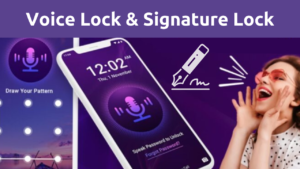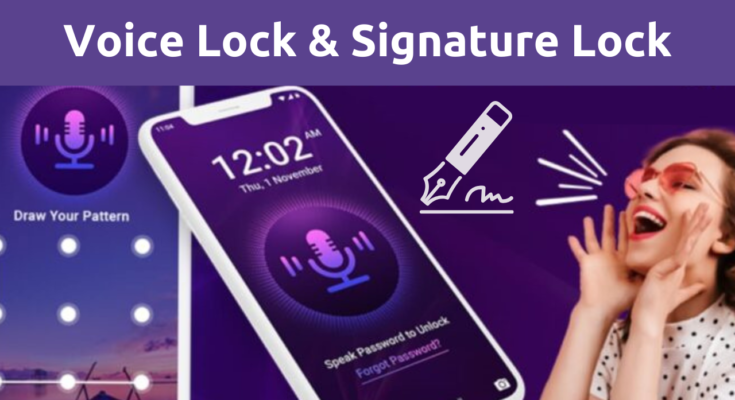Best Locks- New Voice Lock and Signature Lock- In today’s digital age, smartphones have become an indispensable part of our lives, holding vast amounts of personal and sensitive information. To protect this data from unauthorized access, phone manufacturers have implemented various security measures, ranging from traditional PINs to cutting-edge biometric authentication methods.
Best Locks For Android & IOS
Understanding the different types of phone locks and their strengths and weaknesses can help users make informed decisions about securing their devices. Let’s delve into the diverse landscape of phone locks.
Voice Lock
Voice lock, also known as voice recognition, is an innovative biometric authentication method that leverages the distinct characteristics of an individual’s voice to grant access to a device or system. By analyzing factors such as pitch, tone, cadence, and other vocal attributes, voice lock technology creates a unique voiceprint for each user. Users can unlock their devices simply by speaking a predetermined passphrase or phrase, making it a convenient and hands-free authentication method.
However, voice lock systems must contend with challenges such as background noise, variations in voice due to illness or mood, and potential susceptibility to impersonation. Despite these challenges, voice lock offers a promising avenue for secure and user-friendly authentication in various applications, from smartphones to smart home devices and beyond.
Signature lock
Signature lock is a unique form of authentication that allows users to unlock their devices by drawing a personalized signature on the screen. Similar to traditional pen-and-paper signatures, users create a distinct pattern or shape that serves as their digital signature. This method offers a blend of security and convenience, as users can choose intricate patterns that are difficult to replicate while enjoying a tactile and intuitive unlocking experience.
However, signature lock systems may be susceptible to security breaches if the signature pattern is observed or copied, and they may not offer the same level of security as more advanced biometric methods. Nonetheless, for users seeking a balance between security and ease of use, signature lock provides an appealing option for protecting their devices and sensitive information.
PINs (Personal Identification Numbers)
One of the oldest and simplest forms of phone locks is the PIN. Users set a numerical code (usually 4 to 6 digits) that must be entered to unlock the device. PINs offer basic security and are easy to set up. However, they are susceptible to being guessed or cracked through brute force attacks, especially if users choose easily predictable combinations like “1234” or their birthdates.

Passwords:
Similar to PINs, passwords require users to enter a specific sequence of characters (letters, numbers, and symbols) to gain access to their phones. Passwords offer greater complexity and thus higher security compared to PINs. Users can create longer and more intricate combinations, making them harder to crack. However, remembering complex passwords can be challenging, leading some users to opt for simpler and less secure options.
Pattern Locks:
Pattern locks provide a visual alternative to traditional PINs and passwords. Users draw a pattern by connecting dots on a grid displayed on the screen. While pattern locks offer a more intuitive and engaging user experience, they may not be as secure as alphanumeric passwords. Smudge marks on the screen or observing the pattern being drawn can compromise its security.
Fingerprint Recognition:
Biometric authentication methods, such as fingerprint recognition, offer enhanced security and convenience. With fingerprint sensors embedded in modern smartphones, users can unlock their devices simply by placing their registered finger on the sensor. Fingerprint recognition is fast, reliable, and difficult to spoof, making it one of the most popular forms of phone lock. However, it’s essential to note that fingerprints can be copied or replicated under certain circumstances, raising privacy concerns.
Facial Recognition:
Facial recognition technology utilizes the front-facing camera of smartphones to authenticate users based on their facial features. This method offers seamless authentication, as users only need to look at their devices to unlock them. Facial recognition can be highly secure when implemented with advanced algorithms and hardware. However, it may struggle in low-light conditions or when the user’s appearance changes significantly (e.g., wearing glasses or a hat).
Iris Scanning:
Iris scanning technology analyzes the unique patterns in a user’s iris to authenticate their identity. It offers a high level of security, as iris patterns are highly distinctive and difficult to replicate. Iris scanning is also contactless, making it convenient and hygienic, especially in times of heightened awareness about germ transmission. However, integrating iris scanners into smartphones can increase manufacturing costs, limiting their widespread adoption.
Voice Recognition:
Voice recognition systems use the unique characteristics of a user’s voice to verify their identity. Users speak a passphrase or predetermined phrase, and the system compares their voice patterns against stored samples. While voice recognition offers hands-free authentication, it may not be as reliable as other biometric methods. Factors such as background noise, illness, or changes in voice tone can affect accuracy.
Geolocation Locks:
Geolocation locks restrict access to a device based on its physical location. Users can define trusted locations (e.g., home or office) where the phone remains unlocked, while it requires additional authentication elsewhere. Geolocation locks add an extra layer of security, especially for devices that are prone to theft or unauthorized access. However, they rely on GPS accuracy, which can be compromised in certain environments or by spoofing techniques.
Behavioral Biometrics:
Behavioral biometrics analyze patterns of user behavior, such as typing speed, touchscreen gestures, or navigation habits, to authenticate their identity. This approach offers continuous authentication, adapting to changes in user behavior over time. Behavioral biometrics can enhance security without inconveniencing users with frequent authentication prompts. However, collecting and analyzing behavioral data raises privacy concerns and requires robust security measures to protect sensitive information.



